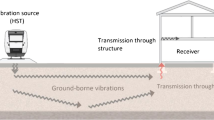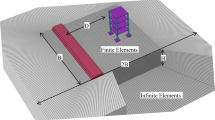Abstract
The number of artificial sources of ground-borne vibrations is escalating with an increase in the construction activities of rail and road traffic systems. These ground-borne vibrations may disturb the stability of nearby old structures. The geo-mechanical problems associated with ground-borne vibrations can be solved by analyzing the soil–structure interaction using various numerical methods. Theoretical evaluation and mitigation of ground-borne vibration in sub-structural systems has been explained in the present study with the help of practical application. First, the open and infill trench methods of vibration mitigation and their efficiency are discussed. Then the assessment of blast-induced vibrations soil parameters and the response of the railway track system under cyclic loading are briefly reviewed. An emphasis has been given on evaluating the effect of vibrations induced by construction activities such as tunneling, blasting, piling, on heritage structures in the nearby area. The impact of proposed tunneling operations on adjacent heritage structures has been assessed and explained through a case study.
Access this chapter
Tax calculation will be finalised at checkout
Purchases are for personal use only
Similar content being viewed by others
References
Amado-Mendes, P., Alves, P., Godinho, L., & Lopes, P. (2015). 2.5D MFS–FEM model for the prediction of vibrations due to underground railway traffic. Engineering Structures, 104, 141–154.
Auersch, L. (2005). The excitation of ground vibration by rail traffic: Theory of vehicle track-soil interaction and measurements on high-speed lines. Journal of Sound and Vibration, 284(1), 103–132.
Bharti, R. K., Choudhury, D., & Chauhan, S.: Behaviour of subgrade under cyclic load below railway track. In Proceedings of Indian geotechnical conference, IGC-2006, December 14–16, 2006, IIT Madras (pp. 731–7320). Chennai.
Bose, T., Choudhury, D., Sprengel, J., & Ziegler, M. (2018). Efficiency of open and infill trenches in mitigating ground-borne vibrations. Journal of Geotechnical and Geoenvironmental Engineering, 144(8), 04018048.
British Standard, BS 5228.2:2009+A1: Code of practice for noise and vibration control on construction and open sites – Part 2: Vibration (2014).
Cenek, P. D., Sutherland, A. J., & Mclver, I. R. (2012). Ground vibration from road construction, 485.
Choudhury, D., Bharti, R. K., Chauhan, S., & Indraratna, B. (2008). Response of multilayer foundation system beneath railway track under cyclic loading. Journal of Geotechnical and Geoenvironmental Engineering, 134(10), 1558–1563.
Choudhury, D., Patil, M., Ranjith, P. G., & Zhao, J. (2019). Dynamic tunnel-soil interaction in soft soils considering site-specific seismic ground response. In Frontiers in geotechnical engineering (pp. 249–271). Springer.
Galvín, P., & Domínguez, J. (2007). High-speed train-induced ground motion and interaction with structures. Journal of Sound and Vibration, 307(3–5), 755–777.
Galvín, P., Francois, S., Schevenels, M., Bongini, E., Degrande, G., & Lombaert, G. (2010). A 2.5D coupled FE-BE model for the prediction of railway induced vibrations. Soil Dynamics and Earthquake Engineering, 30(12), 1500–1512.
German Standard, DIN 4150–3: Structural Vibration – Part 3: Effects of vibration on structures (1999).
He, C., Zhou, S., Di, H., Guo, P., & Xiao, J. (2018). Analytical method for calculation of ground vibration from a tunnel embedded in a multi-layered half-space. Computers and Geotechnics, 99, 149–164.
Hiller, D. M., & Crabb, G. I. (2000). Groundborne vibration caused by mechanised construction works. TRL Report 429. Wokingham: TRL (2000).
Hussein, M., Francois, S., Schevenels, M., Hunt, H., Talbot, J., & Degrande, G. (2014). The fictitious force method for efficient calculation of vibration from a tunnel embedded in a multi-layered half-space. Journal of Sound and Vibration, 333(25), 6996–7018.
Indian Standard, I.S. 6922: Criteria for safety and design of structures subjected to underground blast. Bureau of Indian Standards, New Delhi, India (1973).
Kumar, R., Choudhury, D., & Bhargava, K. (2012). Response of foundations subjected to blast loadings: State of the art review. Disaster Advances, 5(1), 54–63.
Kumar, R., Choudhury, D., & Bhargava, K. (2013). Recent development in modeling, analysis and design of foundation systems subjected to blast loading considering uncertainties. In Proceedings of the international symposium on engineering uncertainty: Safety assessment and management (ISEUSAM – 2012b) (pp. 927–938). Springer, India (2013).
Kumar, R., Choudhury, D., & Bhargava, K. (2014a). Prediction of blast-induced vibration parameters for soil sites. International Journal of Geomechanics, 14(3), 04014007.
Kumar, R., Choudhury, D., & Bhargava, K. (2014b). Response of shallow foundation in rocks subjected to underground blast loading using FLAC3D. Disaster Advances, 7(2), 64–71.
Kumar, R., Choudhury, D., & Bhargava, K. (2015). Simulation of rock subjected to underground blast using FLAC3D. Japanese Geotechnical Society Special Publication, 2(12), 508–511.
Kumar, R., Bhargava, K., & Choudhury, D. (2016). Estimation of engineering properties of soils from field SPT using random number generation. INAE Letters, 1(3–4), 77–84.
Kumar, R., Choudhury, D., & Bhargava, K. (2016). Determination of blast-induced ground vibration equations for rocks using mechanical and geological properties. Journal of Rock Mechanics and Geotechnical Engineering, 8(3), 341–349.
Kumar, R., Bhargava, K., & Choudhury, D. (2017). Correlations of uniaxial compressive strength of rock mass with conventional strength properties through random number generation. International Journal of Geomechanics, 17(2), 06016021.
Kumar, R., Bhargava, K., & Choudhury, D. (2019). Effect of underground blast on underlying ground media below substructure. In R. Sundaram, J. T. Shahu, & V. Havanagi, (Eds.), Geotechnics for transportation infrastructure. Lecture notes in civil engineering (Vol. 28, pp. 363–370). Springer.
Kuo, K., Hunt, H., & Hussein, M. (2011). The effect of a twin tunnel on the propagation of groundborne vibration from an underground railway. Journal of Sound and Vibration, 330(25), 6203–6222.
Lopes, P., Alves, P., Ferraz, M., Calçada, R., & Silva, A. (2014). Numerical modeling of vibrations induced by railway traffic in tunnels: From the source to the nearby buildings. Soil Dynamics and Earthquake Engineering, 61–62, 269–285.
Müller, K., Grundmann, H., & Lenz, S. (2008). Nonlinear interaction between a moving vehicle and a plate elastically mounted on a tunnel. Journal of Sound and Vibration, 310(3), 558–586.
Nandi, R., & Choudhury, D. (2018). Seismic analysis of reinforced soil wall considering oblique pull-out of reinforcements: A review. Geotechnical Engineering, 49(1), 90–98.
Nandi, R., & Choudhury, D. (2019). Seismic analysis and design of embedded cantilever retaining wall considering non-linear earth pressure distribution effect. In Earthquake geotechnical engineering for protection and development of environment and constructions (pp. 4103–4110). CRC Press.
Nandi, R., & Choudhury, D. (2021). Evaluation of Passive Earth Resistance Using an Improved Limit Equilibrium Method of Slices. International Journal of Geomechanics, 21(11), 04021207.
Paolucci, R., & Spinelli, D. (2006). Ground motion induced by train passage. Journal of Engineering Mechanics, Proceedings of ASCE, 132(2), 201–210.
Patil, M., Choudhury, D., Ranjith, P. G., & Zhao, J. (2015). Seismic analysis of tunnels in soft soils: a state of-the-art review. In: Proceeding of the international conference on soft ground engineering (ICSGE 2015), 3–4 Dec 2015 (pp. 625–634). Singapore (2015).
Patil, M., Choudhury, D., Ranjith, P. G., & Zhao, J. (2017). A numerical study on effects of dynamic input motion on response of tunnel-soil system. In Proceeding of the 16th world conference on earthquake engineering (16th WCEE 2017), Paper ID: 3313. Santiago.
Patil, M., Choudhury, D., Ranjith, P. G., & Zhao, J. (2018). Behavior of shallow tunnel in soft soil under seismic conditions. Tunnelling and Underground Space Technology, 82, 30–38.
PLAXIS 2D v2017.1.0 [Computer software]. PLAXIS BV, Netherlands.
PLAXIS 3D v2017.1.0 [Computer software]. PLAXIS BV, Netherlands.
Thusyanthan, N. I., & Madabhushi, S. P. G. (2003). Experimental study of vibrations in underground structures. Proceedings of Institution of Civil Engineers - Geotechnical Engineering, 156(2), 75–81.
Trochides, A. (1991). Ground-borne vibrations in buildings near subways. Applied Acoustics, 32(4), 289–296.
Tsuno, K., Morimoto, W., Itoh, K., Murata, O., & Kusakabe, O. (2005). Centrifugal modeling of subway-induced vibration. International Journal of Physical Modelling in Geotechics, 5(4), 15–26.
Yang, W. B., Hussein, M. F. M., & Marshall, A. M. (2013a). Centrifuge and numerical modelling of ground-borne vibration from surface sources. Soil Dynamics and Earthquake Engineering, 44(1), 78–89.
Yang, W. B., Hussein, M. F. M., & Marshall, A. M. (2013b). Centrifuge and numerical modelling of ground-borne vibration from an underground tunnel. Soil Dynamics and Earthquake Engineering, 51(8), 23–34.
Yaseri, A., Bazyar, M. H., & Hataf, N. (2014). 3D coupled scaled boundary finite-element/finite-element analysis of ground vibrations induced by underground train movement. Computers and Geotechnics, 60(1), 1–8.
Yaseri, A., Bazyar, M., & Javady, S. (2018). 2.5D coupled FEM-SBFEM analysis of ground vibrations induced by train movement. Soil Dynamics and Earthquake Engineering, 104, 307–318 (2018).
Yuan, Z., Cai, Y., & Cao, Z. (2016). An analytical model for vibration prediction of a tunnel embedded in a saturated full-space to a harmonic point load. Soil Dynamics and Earthquake Engineering, 86, 25–40.
Yuan, Z., Bostrom, A., & Cai, Y. (2017). Benchmark solution for vibrations from a moving point source in a tunnel embedded in a half-space. Journal of Sound and Vibration, 387, 177–193.
Acknowledgements
Authors want to acknowledge the partial funding received from GeoDynamics vide project number RD/0218-CEGEODS-506 to carry out a portion of the work reported in this paper. Also, a portion of the technical content of this article is reproduced from past literature (Figures) to set the tone of the current study. In accordance, the authors are grateful to American Society of Civil Engineers (ASCE) for granting the permission to reproduce/reuse the appropriate figures in this article.
Author information
Authors and Affiliations
Corresponding author
Editor information
Editors and Affiliations
Rights and permissions
Copyright information
© 2023 The Author(s), under exclusive license to Springer Nature Singapore Pte Ltd.
About this chapter
Cite this chapter
Choudhury, D., Patil, M., Nandi, R. (2023). Controlled Ground-Borne Vibrations for Design of Sub-structural Systems—Theory and Practice. In: Sitharam, T.G., Jakka, R.S., Kolathayar, S. (eds) Advances in Earthquake Geotechnics. Springer Tracts in Civil Engineering . Springer, Singapore. https://doi.org/10.1007/978-981-19-3330-1_3
Download citation
DOI: https://doi.org/10.1007/978-981-19-3330-1_3
Published:
Publisher Name: Springer, Singapore
Print ISBN: 978-981-19-3329-5
Online ISBN: 978-981-19-3330-1
eBook Packages: EngineeringEngineering (R0)




